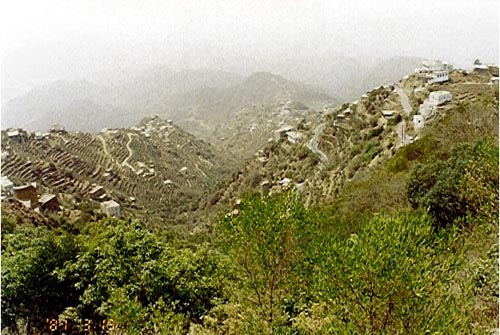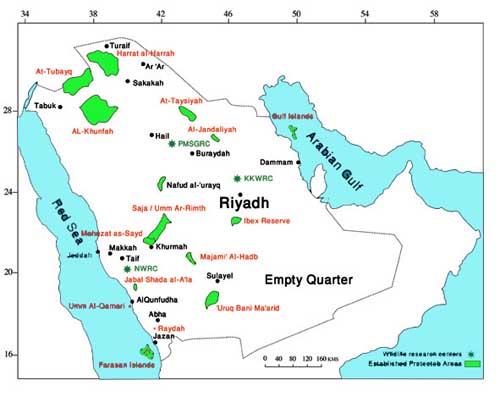One of the important steps towards the conservation of our wild plants is to expand the floristic knowledge. Among the species so far recorded from Saudi Arabia, approximately 30% of species are rare or seen in restricted localities and about 18 species are believed locally extinct. A provisional candidate list of endangered plant species was prepared by Meteorology and Environmental Protection Agency (MEPA) in 1985, primarily based upon the collections and observations of S. Collenette (a well known plant collector) but without categorizing the status of each species. In 1987, another list of about 50 species was published, each with a status such as Endangered (E), Vulnerable (V), Rare (R) and insufficiently known (K). The status of most of these species is now almost certain that these species now occur in 15 or fewer than 10 square kilometers. But this list does not contain any threatened annual plants nor the extinct species. Yet this list deserves the credit of having some of the most threatened species of Saudi Arabia. The importance of awareness among people and the need for the continued existence of our wild gene pool are also well depicted in different reports and articles. Other problems portrayed in these articles such as: the dangers operating on some of the rare wild populations and the consequences in the aftermath of the continued destruction of certain dominant species in the vegetation rich mountains are also thought provoking. Recently a strategy, including a preliminary list containing over 100 threatened species has been prepared by the NCWCD, not only to highlight the importance of protecting the threatened species but to give guidance to protect critical habitats that host extraordinarily high species diversity. It also explores specific ways that help conservation groups to reverse the present trends of intentional and unintentional habitat destruction.
Disturbances in the environment can be natural or man made. Natural disturbances, may be events which cause abrupt structural change in plant communities, is an integral part of the pattern in most parts of the Kingdom's landscapes. Desert encroachment and drought are the two major natural disturbances operating in the rangelands. According to conservationists in this part of the world, sand dune movement, unsustainable use of natural resources and drought are the real culprits behind environmental degradation. However, dry weather is normal and severe drought has come and gone for countless ages without devastating the plants' composition except for the overall stature of the species (particularly the herbaceous flora) and the amount of seed production. Drought in consecutive years may pose a threat to vulnerable plants if their seed deposits in the soil decrease dramatically over a period of time. Intentional disturbances, on the other hand, will have drastic effects on the environment. In most cases these changes are irreversible. The main disturbances can be as: the breakdown of traditional pastoral practices and continued staying of domestic herds in one region, breakdown and abandoning of traditional rangeland management, abandoning and shifting of agricultural areas either due to non profitability, inappropriate irrigation practices resulting in the salinization or alkalization, off road driving and picnicking, clearance of woodland for fuel-wood and charcoal, urban development on mountains and species-rich areas, etc.
It may not be possible at this stage to make a complete analysis of the many factors which threaten the individual components of the flora of Saudi Arabia. There are instances in which a species may become rare in a habitat. Apart from habitat destruction and other outside influences, lack of enough pollinating agents like beetles, butter flies, honey bees; long dormancy periods and failure to produce enough viable seeds are also contributing factors. Effect of fungal pathogens and aphids living on plants, especially in flowers, are also a threat. In both cases they can produce a major shift in the life history of plants, and thereby reduce the chances of producing enough viable seeds or even kill the plant at a much earlier stage.
Saudi Arabia is one of the most vulnerable countries in this region. There are many reasons about these vulnerabilities, and these are explained in the climate change 2001, at the Third Assessment report of the Intergovernmental Panel on Climate Change (IPCC). The report established how human activity (burning fossil fuels and changes in land use) is modifying the global climate with temperatures rises projected for the next 100 years that could affect human welfare and the environment. The climatic record of this region for the past five years showed that there were fluctuations in the temperature and a decrease in rainfall over large portions of Saudi Arabia. In the 21st century, this warning trend, and changes in precipitation patterns are expected to continue along with a rise in sea level and increased frequency of extreme weather events.
Saudi Arabia's biodiversity is under threat from multiple stresses. Climate change is one of the several pressures. Although climate changes will have consequences all over Saudi Arabia, not all regions will be affected equally, nor all regions equally vulnerable to those impacts. Saudi Arabia, being located in the arid part of the world is expected to experience faster warming due to climate change than countries located in the tropical or temperate regions. However, significant variation can be anticipated due to the large size of the country, its diverse landscapes and also due to its Red Sea coast on the western side and the Arabian Gulf on the eastern side.
A regional drought monitoring and early warning centre has established within the PME in May 2003 to coordinate the results of all climate related studies. In addition, the 14th meeting of the IPCC held in Geneva agreed in principle to support the centre with all available expertise. The main goal of the centre is to finalize strategies on various climate changes in order to slow down the increasing danger of drought and also to prepare a work plan to protect the environment and its natural resources. The main objective of the centre is to monitor and analyze the climate data of the past, present and future periods. It also systematically observes the atmospheric, terrestrial and oceanic parameters so as to predict the climate changes in the environment.
At present, Saudi Arabia has 15 protected areas which cover approximately 5% of the land area and conserve about 43% of the country's flora. The NCWCD has developed a national system plan in 1990 after an extensive field survey and a wide range of consultation. As per this system plan, 104 sites (both marine and terrestrial) have been identified to declare as protected areas. The sites include areas with key biotopes and landscapes features and covering habitats of critical species in the Kingdom.
Significant number of scientific publications and reports have been appeared in the past to demonstrate the dangers and disturbances operating in the habitats of Saudi Arabia. In all these works, the message was to conserve the wild species and their habitats. At times, the common message raised by botanists and conservationists like "a large number of species in our environment are threatened and we need to pay attention for their conservation"- will be less effective (as suggested by SSC Chairman, 2001) and will eventually loss credibility if we cannot or do not back it up with the information and reasoning we have used to arrive that conclusion.


|
|
|||||||||||||||||||||||||||||||||||||||||||||||
|
|
|
|
|||||||||||||||||||||||||||||||||||||||||||||
|
|
|||||||||||||||||||||||||||||||||||||||||||||||
|
|
||
|
|
Protected areas managed by the Ministry of Agriculture
Partially fenced Rangelands
Protected
woodlands Popular Hima systems: 1. Shaib Huraymila 2. Hima Al Gatha at Unaiza 3. Hima Saysad 4. Hima Bani Saar |
|
|
|
||